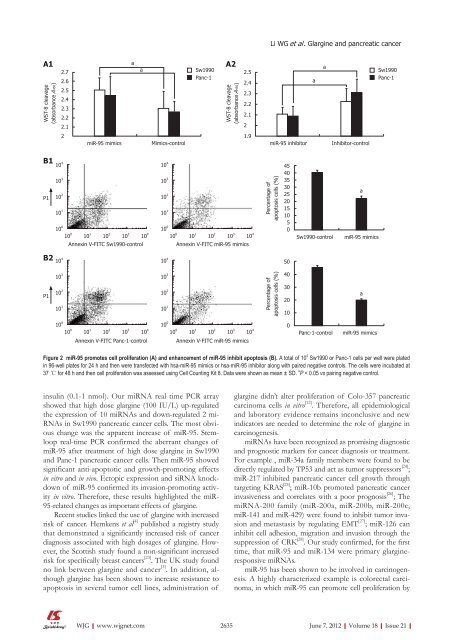Evidence base and patients' perspective - World Journal of ...
Evidence base and patients' perspective - World Journal of ...
Evidence base and patients' perspective - World Journal of ...
You also want an ePaper? Increase the reach of your titles
YUMPU automatically turns print PDFs into web optimized ePapers that Google loves.
A1<br />
2.7<br />
a<br />
a Sw1990<br />
A2<br />
2.5<br />
a<br />
Sw1990<br />
2.6<br />
Panc-1<br />
2.4<br />
a<br />
Panc-1<br />
2.5<br />
2.3<br />
2.4<br />
2.3<br />
2��2<br />
2��2<br />
2��1<br />
2��1<br />
2<br />
WST-8 cleavage<br />
(absorbance A 450)<br />
2<br />
B1 10 4<br />
P1<br />
P1<br />
10 3<br />
10 2<br />
10 1<br />
10 0<br />
B2 10 4<br />
10 3<br />
10 2<br />
10 1<br />
10 0<br />
miR-95 mimics Mimics-control<br />
10 0 10 1 10 2 10 3 10 4<br />
Annexin V-FITC Sw1990-control<br />
10 0 10 1 10 2 10 3 10 4<br />
Annexin V-FITC Panc-1-control<br />
Figure 2 miR-95 promotes cell proliferation (A) <strong>and</strong> enhancement <strong>of</strong> miR-95 inhibit apoptosis (B). A total <strong>of</strong> 10 4 Sw1990 or Panc-1 cells per well were plated<br />
in 96-well plates for 24 h <strong>and</strong> then were transfected with hsa-miR-95 mimics or hsa-miR-95 inhibitor along with paired negative controls. The cells were incubated at<br />
37 ℃ for 48 h <strong>and</strong> then cell proliferation was assessed using Cell Counting Kit 8. Data were shown as mean ± SD. a P < 0.05 vs pairing negative control.<br />
insulin (0.1-1 nmol). Our miRNA real time PCR array<br />
showed that high dose glargine (100 IU/L) up-regulated<br />
the expression <strong>of</strong> 10 miRNAs <strong>and</strong> down-regulated 2 mi-<br />
RNAs in Sw1990 pancreatic cancer cells. The most obvious<br />
change was the apparent increase <strong>of</strong> miR-95. Stemloop<br />
real-time PCR confirmed the aberrant changes <strong>of</strong><br />
miR-95 after treatment <strong>of</strong> high dose glargine in Sw1990<br />
<strong>and</strong> Panc-1 pancreatic cancer cells. Then miR-95 showed<br />
significant anti-apoptotic <strong>and</strong> growth-promoting effects<br />
in vitro <strong>and</strong> in vivo. Ectopic expression <strong>and</strong> siRNA knockdown<br />
<strong>of</strong> miR-95 confirmed its invasion-promoting activity<br />
in vitro. Therefore, these results highlighted the miR-<br />
95-related changes as important effects <strong>of</strong> glargine.<br />
Recent studies linked the use <strong>of</strong> glargine with increased<br />
risk <strong>of</strong> cancer. Hemkens et al [4] published a registry study<br />
that demonstrated a significantly increased risk <strong>of</strong> cancer<br />
diagnosis associated with high dosages <strong>of</strong> glargine. However,<br />
the Scottish study found a non-significant increased<br />
risk for specifically breast cancers [23] . The UK study found<br />
no link between glargine <strong>and</strong> cancer [3] . In addition, although<br />
glargine has been shown to increase resistance to<br />
apoptosis in several tumor cell lines, administration <strong>of</strong><br />
WJG|www.wjgnet.com<br />
10 4<br />
10 3<br />
10 2<br />
10 1<br />
10 0<br />
10 4<br />
10 3<br />
10 2<br />
10 1<br />
10 0<br />
WST-8 cleavage<br />
(absorbance A 450)<br />
1��9<br />
10 0 10 1 10 2 10 3 10 4<br />
Annexin V-FITC miR-95 mimics<br />
10 0 10 1 10 2 10 3 10 4<br />
Annexin V-FITC miR-95 mimics<br />
Li WG et al �� Glargine <strong>and</strong> pancreatic cancer<br />
miR-95 inhibitor Inhibitor-control<br />
Percentage o�<br />
apoptosis cells (%)<br />
Percentage o�<br />
apoptosis cells (%)<br />
45<br />
40<br />
35<br />
30<br />
25<br />
20<br />
15<br />
10<br />
5<br />
0<br />
50<br />
40<br />
30<br />
20<br />
10<br />
0<br />
Sw1990-control miR-95 mimics<br />
Panc-1-control miR-95 mimics<br />
glargine didn’t alter proliferation <strong>of</strong> Colo-357 pancreatic<br />
carcinoma cells in vitro [12] . Therefore, all epidemiological<br />
<strong>and</strong> laboratory evidence remains inconclusive <strong>and</strong> new<br />
indicators are needed to determine the role <strong>of</strong> glargine in<br />
carcinogenesis.<br />
miRNAs have been recognized as promising diagnostic<br />
<strong>and</strong> prognostic markers for cancer diagnosis or treatment.<br />
For example , miR-34a family members were found to be<br />
directly regulated by TP53 <strong>and</strong> act as tumor suppressors [24] ;<br />
miR-217 inhibited pancreatic cancer cell growth through<br />
targeting KRAS [25] ; miR-10b promoted pancreatic cancer<br />
invasiveness <strong>and</strong> correlates with a poor prognosis [26] ; The<br />
miRNA-200 family (miR-200a, miR-200b, miR-200c,<br />
miR-141 <strong>and</strong> miR-429) were found to inhibit tumor invasion<br />
<strong>and</strong> metastasis by regulating EMT [27] ; miR-126 can<br />
inhibit cell adhesion, migration <strong>and</strong> invasion through the<br />
suppression <strong>of</strong> CRK [28] . Our study confirmed, for the first<br />
time, that miR-95 <strong>and</strong> miR-134 were primary glargineresponsive<br />
miRNAs.<br />
miR-95 has been shown to be involved in carcinogenesis.<br />
A highly characterized example is colorectal carcinoma,<br />
in which miR-95 can promote cell proliferation by<br />
2635 June 7, 2012|Volume 18|Issue 21|<br />
a<br />
a

















